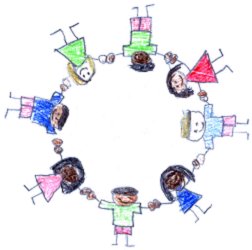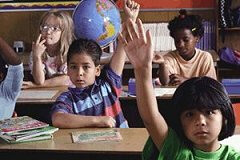|
|
 |
|
Immigrants and their hardships:
-"In the 2003-2004 school year, almost 5 million [ELLs] were enrolled in public schools," representing "more
than 10 percent of the total school enrollment, and a 40.7 percent increase from 1993-1994" (Weinstein, 2007). This number
has been moving up. Bilingual education is an approach explored by educators in an attempt to assuage the inequity that arises
in educating a population that is not of the dominant culture.
-"There is an English speaking hegemony in our country that will always place ELL students at an unfair hindrance
by being geographically different."
- English = the U.S. language of power, success, academia.
- Lau v. Nichols
Need for further toleration:
- ELLs sometimes given labels (slow, LD) and might not deserve it
- Segregation can occur outside of the classroom due to student comfort levels about their cultural and linguistic differences
(lunchroom, extra curricular activities

|
 |
|
There are five major types of instruction utilized when teaching ELL students:
(1) Submersion
o ELL students in classes where only English is spoken and used for instruction.
-Primary language is not seen at all in this setting
o Why Submersion?
-English is used more prevalently
-English is the language of success and power in the U.S.
-Acculturation and preparation for higher learning and/ or the future
o Why not Submersion?
-Failure to acknowledge language, etc. does not demonstrate that the teacher respects the culture from which here
students came.
(2) English as a Second Language (ESL)
o Slightly more accommodating.
-English spoken exclusively in instruction
-Some support in primary language is given in academic content
-Occasional use
(3) Transitional Bilingual Education (TBE)
o Attempt to wean students off primary language in exchange for English
-Gradual process; In about 1-3 years, students should know English
-Some use of primary language in instruction
o Only to augment English learning
o Students can see some connection with their culture when using primary language
(4) Maintenance Bilingual Education (MBE)
o ELL Students will attain literacy proficiency in both English and the primary language.
(5) Dual Language Programs
o Attempts to achieve proficiency and fluency in both English and the primary language
-Not only ELL students. This program is meant to provide proficiency for all students!
o Most difficult to implement

|
 |
|
|
|
 |
 |
|
Generic Teacher Checklist
Inside the classroom: Education and Pedagogy
o Must be a solid communicator and have good command of language
-Need to make themselves clear in their teaching so others can understand.
-Need strategies for determining what students are saying
o Must understand linguistics and cultural discourse patterns
-They are not superior or universal
-Expose themselves and students to new vocabulary chunked with related terms
o Must have accept and desire to connect with different cultures of students.
-Demonstrates compassion, caring, and interest in the students.
-Shows a willingness to help students succeed with use of their own culture.
-Does not demean cultural/familial backgrounds in any way.
o Must have a welcoming, flexible environment
-ELL students must feel it is alright to make mistakes.
-Students bring different speech patterns as a result of their cultures which reflect their concept of identity and worldview.
-Must be flexible for all immigrant children (Hispanic, Asian, Polish, Jewish, etc.)because they all learn differently
and have different perceptions about the world.
Activities and Assessment
-Assignments and Assessment should be geared toward higher level thinking
o Teachers should have high expectations of all their students.
o Verbal input should be slightly more challenging than what ELLs could handle in order to promote academic growth (Stritikus
and Varghese)
o Content quality over language proficiency- but both should be valued.
-Give commentary on strengths and mistakes (in a non-demeaning way) so as to not frustrate or embarrass students where
the become isolated. Mistakes should be pointed out but students should not be humiliated.
o Assessment should vary and be geared toward student strengths.
Outside the Classroom
o Teachers must educate themselves on Bilingual education and second language learning.
-A sensitivity to language issues and difficulties can develop.
o Classes taken in diverse cultures and languages, as well as a linguistic course on politics and policy.
|
 |
|
|
|
|

Final thoughts about what we can do as educators:
-Opt for bilingual education. THERE IS NO DOWN SIDE!
-There are case studies available that make a case for both bilingual education and submersion like situations.
-Promote preservation of the culture and language
-This will cultivate a nurturing environment for students
-Provides pluralism
-If culture impacts the way a student thinks, how can we as educators ever hope to know what the student really thinks
if we don't understand their culture and therefore their perception of their world?
-Keeping culture will prevent the student's alienation/isolation from his or her immigrant family.
-Culture can be used in lessons to demonstrate that the teacher knows something about who his or her students are.
- Make it very clear that ENGLISH IS THE LANGUAGE OF POWER AND SUCCESS.
-Make sure it is used often and a lot.
-Make sure it is understood the differences between conversational and academic English (the written word).
|
|
|
 |

